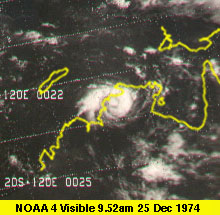
On December 25, 1974, Darwin, Australia received an unwelcome night visitor. Not Father Christmas, but Cyclone Tracy, a small but intense tropical cyclone, struck the city at 3:30 AM local time. The storm had been forecast to pass west of the city, but overnight Tracy made a tight turn to the southeast to ravage the coast.
Tracy had formed from a disturbance that had organized near the equator five days before hand. It was tracked by U.S. satellites and Darwin radar as it moved slowly to the southwest. However, once it passed by Bathurst Island, it changed course and headed directly toward Darwin. The maximum sustained winds increased from 75 mph (120 km/hr) when it rounded Bathurst Island to 125 mph (205 km/hr) when it came ashore. This caught most of the city residents by surprise and a prior false alarm for another storm had left many citizen’s blase about the warnings. Darwin had just undergone a building boom over the previous decade and many of its new buildings hadn’t been built to the code. Nearly 70 people perished in the storm and most of the US$800 million in damages was done to homes.

Due to the lack of infrastructure left and the threat to the health of survivors, over 10,000 residents were evacuated from the city. Eventually, enough new houses were rebuilt to allow most of the population to return, but even after five years nearly 60% of the city’s pre-Tracy populace decided not to come back. The storm did prompt Australia’s federal government to cede more autonomy to the Northern Territory, of which Darwin is the capital.